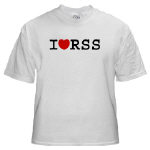
 My mother, who has a WordPress blog, keeps telling me about posts that I haven't seen. This was starting to irk me, so I looked into River2 to see what's going on. Yes, it is finding her posts, but it thinks they're pictures. Why? Because the feed says they're pictures. Oy.
My mother, who has a WordPress blog, keeps telling me about posts that I haven't seen. This was starting to irk me, so I looked into River2 to see what's going on. Yes, it is finding her posts, but it thinks they're pictures. Why? Because the feed says they're pictures. Oy. 
 Digging in a little deeper. WordPress has a neat feature that I don't fully understand, called "gravatars." If you have one, as my mother does, it attaches it to every post, as an image. I'm sure she has absolutely no idea what a gravatar is, and I'm equally sure that WordPress created one for her automatically.
Digging in a little deeper. WordPress has a neat feature that I don't fully understand, called "gravatars." If you have one, as my mother does, it attaches it to every post, as an image. I'm sure she has absolutely no idea what a gravatar is, and I'm equally sure that WordPress created one for her automatically. 
 So, I want to fix this, so her posts (and those of other WordPress authors) show up where they belong in River2. Other than looking at the URL of the image, I have no idea how to do it. I'm hoping one of the readers of this blog does.
So, I want to fix this, so her posts (and those of other WordPress authors) show up where they belong in River2. Other than looking at the URL of the image, I have no idea how to do it. I'm hoping one of the readers of this blog does. 
 Here's an example from the feed.
Here's an example from the feed. 
 <media:content url="http://0.gravatar.com/avatar/ed80e40fc7fa8d76b88e3e5d1079f429?s=96&d=identicon&r=G" medium="image">
<media:content url="http://0.gravatar.com/avatar/ed80e40fc7fa8d76b88e3e5d1079f429?s=96&d=identicon&r=G" medium="image"> 
 They use the media:content element to represent the gravatar. I have a strong feeling this is very wrong. It seems to me that a gravatar is a bit of metadata. Why should it be represented as an image, why not as a <gravatar> in a new namespace defined for the purpose of representing gravatars?
They use the media:content element to represent the gravatar. I have a strong feeling this is very wrong. It seems to me that a gravatar is a bit of metadata. Why should it be represented as an image, why not as a <gravatar> in a new namespace defined for the purpose of representing gravatars? 
 The media:content element came into being to help Flickr attach pictures to items in feeds. It probably was a mistake, in hindsight, to try to make a general namespace for this, because it gets us into jams like this. Probably would have worked better if they had come up with a <flickr:picture> element. That way we might not have had this conflict in semantics.
The media:content element came into being to help Flickr attach pictures to items in feeds. It probably was a mistake, in hindsight, to try to make a general namespace for this, because it gets us into jams like this. Probably would have worked better if they had come up with a <flickr:picture> element. That way we might not have had this conflict in semantics. 
 <media:content url="http://farm3.static.flickr.com/2785/4317723874_9ac5cf85e5_o.jpg" type="image/jpeg" height="1880" width="2816"/>
<media:content url="http://farm3.static.flickr.com/2785/4317723874_9ac5cf85e5_o.jpg" type="image/jpeg" height="1880" width="2816"/> 
 I'm pretty stuck here. I really need to separate pictures from non-picture items (I subscribe to some awesome picture feeds, and they would completely swamp my news-oriented feeds). It looks like I'm going to have to check if the image comes from gravatar.com. That's a terrible way to parse metadata.
I'm pretty stuck here. I really need to separate pictures from non-picture items (I subscribe to some awesome picture feeds, and they would completely swamp my news-oriented feeds). It looks like I'm going to have to check if the image comes from gravatar.com. That's a terrible way to parse metadata. 